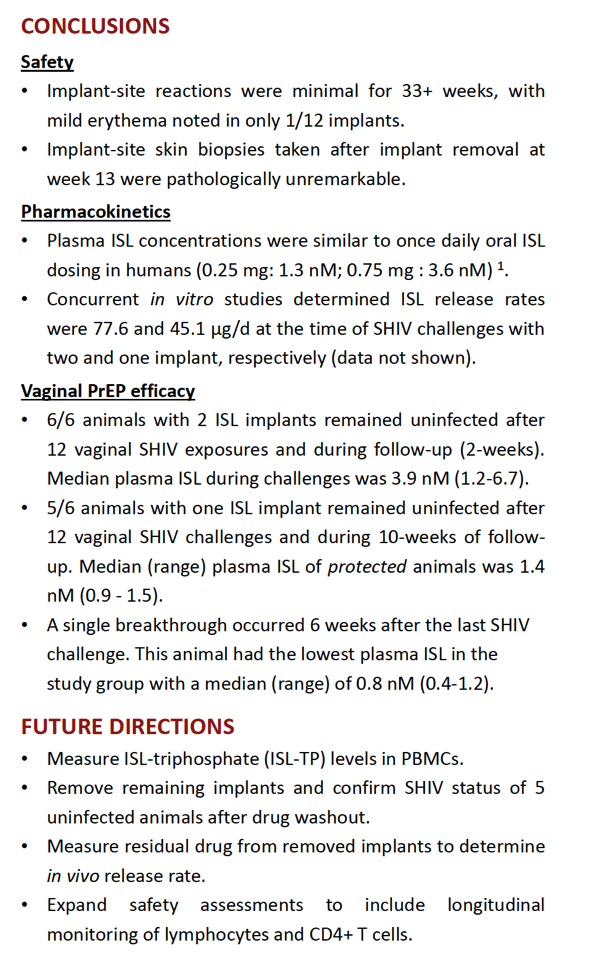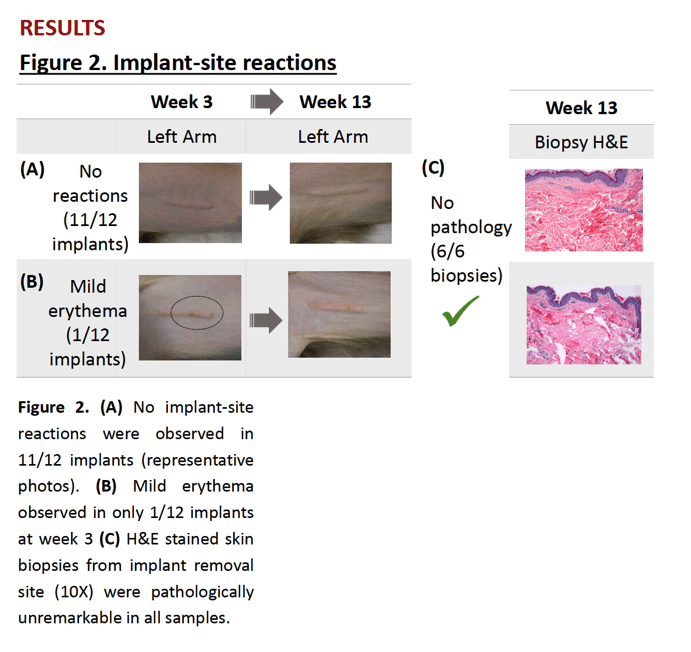 |
 |
 |
| |
Vaginal PrEP Efficacy of Biodegradable Islatravir Implants in Macaques
Islatravir Implant Protects Macaques From Vaginal SHIV Infection
|
| |
| |
30th CROI, Conference on Retroviruses and Opportunistic Infections, February 19-22, 2023, Seattle
Mark Mascolini
One or two biodegradable islatravir implants protected 5 of 6 female macaque monkeys from 24 vaginal simian HIV (SHIV) challenges delivered in two 6-week periods then through 2 to 10 weeks of follow-up [1]. One breakthrough infection happened 6 weeks after the final SHIV challenge in the animal with the lowest islatravir levels in blood.
Scientists continue to study potent antiretrovirals with long half-lives to find candidates for long-acting pre-exposure prophylaxis (PrEP) against HIV infection. Putting such a preventive agent in an implant could prevent transmission of HIV while obviating concerns about adherence and enhancing privacy of PrEP use.
Islatravir, a potent and durable nucleoside reverse transcriptase inhibitor with a long intracellular half-life, is one such candidate. Researchers from the Centers for Disease Control and Prevention (CDC) and colleagues from other institutions conducted this study of islatravir placed in a biodegradable implant and tested in macaque monkeys challenged vaginally with SHIV.
Reservoir-style implants built with a biodegradable polymer were filled with 46 +/- 2 mg of islatravir in PEG40-castor oil and implanted in the animals' arms. Projected in vitro release rate was 83 μg daily.
The researchers tested two implants in 6 animals then removed 1 implant and tested the remaining implant in the same 6 animals. In both study phases, the researchers assessed safety and pharmacokinetics of the islatravir implants for 5 weeks, then challenged the macaques vaginally with SHIV twice weekly for 6 weeks. In the two-implant study, follow-up after 6 weeks of challenge lasted 2 weeks, then the researchers removed one implant from each animal, spent another 5 weeks reassessing pharmacokinetics, then challenged with SHIV again. In the one-implant phase follow-up after 6 weeks of twice-weekly challenges lasted at least 6 weeks. The investigators compared infection outcomes in these 6 macaques with outcomes in 2 placebo-implanted controls and 4 historical controls with no implants.
Eleven of 12 implants caused no implant-site reactions for 33 or more weeks. One animal had mild erythema at the implant site at week 3. Biopsies taken from implant removal sites at week 13 showed no pathology.
Islatravir concentrations in plasma were similar to those seen with once-daily oral dosing in humans (1.3 nM with 0.25 mg; 3.6 nM with 0.75 mg) [2]. Concurrent in vitro studies showed that islatravir release rates at the time of SHIV challenge measured 77.6 μg/day with two implants and 45.1 μg/day with one implant.
With two implants all 6 animals remained uninfected by SHIV after 12 exposures in 6 weeks and during 2 weeks of follow-up. Median islatravir plasma concentration during SHIV challenges stood at 3.9 nM (range 1.2 to 6.7). With 1 islatravir implant 5 of 6 animals remained free of SHIV after 12 vaginal challenges in 6 weeks and through 10 weeks of follow-up. In the 5 protected animals, median islatravir plasma concentrations stood at 1.4 nM (range 0.9 to 1.5). The researchers judged these islatravir concentrations "clinically relevant."
The single breakthrough infection in the one-implant phase happened 6 weeks after the last SHIV challenge in the macaque with the lowest islatravir plasma concentration in the study (median 0.8 nM, range 0.4 to 1.2).
All 6 control animals became infected with SHIV within 6 weeks and usually within 4 weeks.
References
1. Daly MB, Kim D, Li L, et al. Vaginal PrEP efficacy of biodegradable islatravir implants in macaques. 30th CROI, Conference on Retroviruses and Opportunistic Infections, February 19-22, 2023, Seattle. Abstract 989.
2. Matthews RP, Rudd DJ, Zhang S, et al. Safety and pharmacokinetics of once-daily multiple-dose administration of islatravir in adults without HIV. J Acquir Immune Defic Syndr. 2021 Nov 1;88(3):314-321. doi: 10.1097/QAI.0000000000002755. PMID: 34651606.
https://journals.lww.com/jaids/Fulltext/2021/11010/Safety_and_Pharmacokinetics_of_Once_Daily.14.aspx
Vaginal PrEP Efficacy of Biodegradable Islatravir Implants in Macaques
CROI 2023 Feb 20-23

Michele B. Daly1, Daniel Kim1, Linying Li2, Archana Krovi2, Chasity Norton2, Catalina Forero1, Marie Brake1, James Mitchell1, Chuong Ding1, Tiancheng E. Edwards1, Mackenzie L. Cottrell3, Walid Heneine1, Gerardo Garcίa- Lerma1,
Charles W. Dobard 1, Leah M. Johnson2
1 Laboratory Branch, Centers for Disease Control and Prevention, Atlanta, United States, 2RTI International, Research Triangle Park, United States, 3UNC Eshelman School of Pharmacy, University of North Carolina at Chapel Hill, United States





|
| |
|
 |
 |
|
|